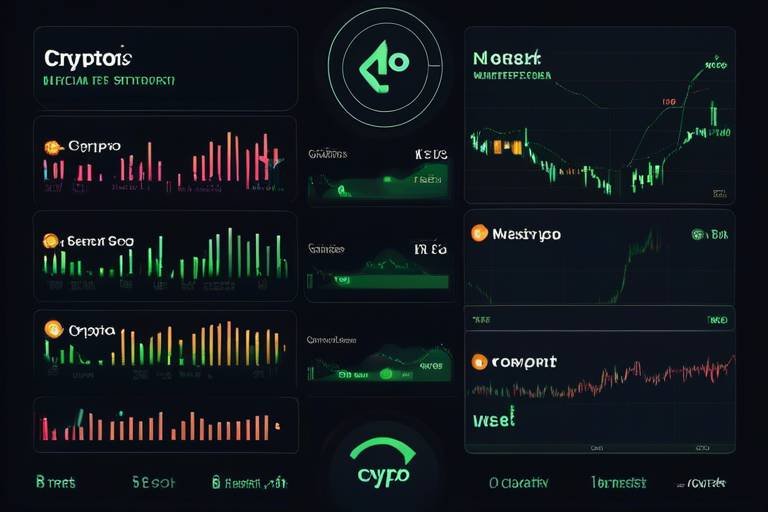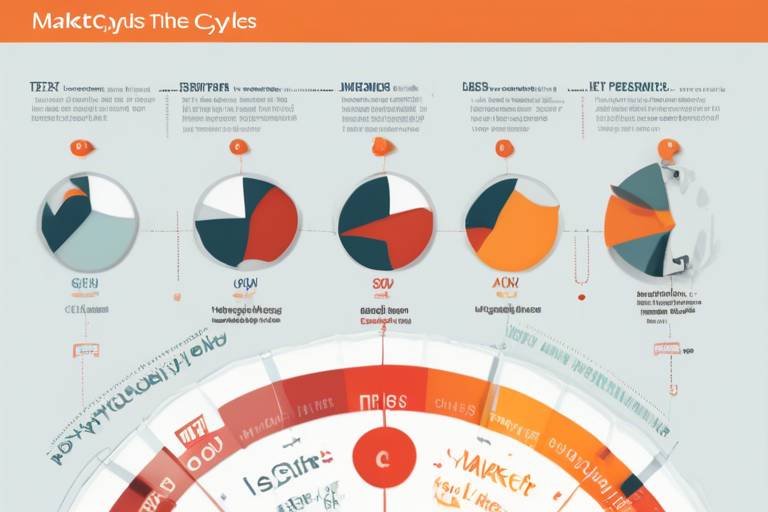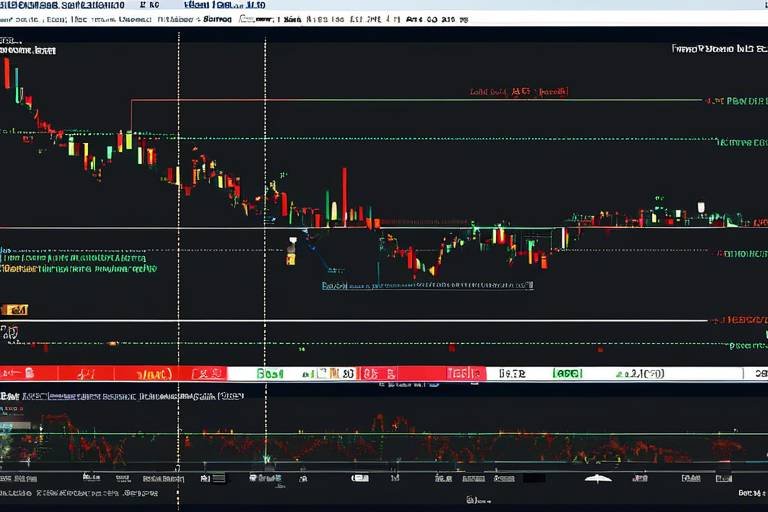How to Utilize Market Sentiment Indicators in Crypto
In the fast-paced world of cryptocurrency trading, understanding market sentiment is not just a nice-to-have; it's a necessity. Imagine trying to navigate a stormy sea without knowing which way the wind is blowing. That's what trading without sentiment indicators feels like. These indicators act as your compass, guiding you through the tumultuous waves of market emotions. By effectively leveraging market sentiment indicators, you can enhance your investment decisions and manage risks more efficiently. But how exactly do you do this? Let’s dive into the intricacies of market sentiment and discover how to use these powerful tools to your advantage.
Market sentiment reflects the overall attitude of investors towards a particular asset, in this case, cryptocurrencies. It’s like the collective mood of the market, shaped by various factors such as news events, market trends, and even social media chatter. Grasping this concept is crucial for crypto traders because it allows them to anticipate price movements and make informed decisions. Think of market sentiment as the heartbeat of the trading community; when it races, it can indicate excitement or fear, which in turn affects the prices of cryptocurrencies. By tuning into this heartbeat, traders can position themselves better in the market.
There are various indicators that can help gauge market sentiment, each providing unique insights into trader psychology and market trends. Some of the most commonly used indicators include:
- Fear and Greed Index: This index quantifies market emotions, helping traders understand whether the market is in a state of fear or greed.
- Social Media Sentiment: Analyzing mentions and sentiment on platforms like Twitter and Reddit can provide insights into public opinion and trends.
- Trading Volume: High trading volumes can indicate strong market sentiment, whether bullish or bearish.
By utilizing these indicators, traders can gain a comprehensive view of the market landscape and make more informed decisions.
The Fear and Greed Index is one of the most widely recognized tools for understanding market sentiment. It quantifies emotions on a scale from 0 to 100, where 0 represents extreme fear and 100 indicates extreme greed. This index is particularly useful for traders looking to identify potential reversals in the market. For instance, if the index shows extreme greed, it might be a signal that the market is overbought, and a correction could be imminent. Conversely, extreme fear might indicate that the market is oversold, presenting a potential buying opportunity.
Interpreting the Fear and Greed Index involves recognizing extreme values that may signal overbought or oversold conditions. For example, if the index reads above 80, it often suggests that traders are overly optimistic, which could lead to a market correction. On the flip side, a reading below 20 may indicate widespread panic, suggesting that it could be a good time to buy. Understanding these signals can empower traders to make timely decisions, whether that means entering or exiting positions.
While the Fear and Greed Index is a valuable tool, it’s important to recognize its limitations. For one, the index can lag behind rapid market changes, meaning traders might miss out on crucial opportunities. Additionally, relying solely on this index without considering other market fundamentals can lead to poor decision-making. It’s essential to use the index as part of a broader strategy that includes technical analysis and market news.
Social media sentiment analysis is another powerful tool for gauging public opinion and trends in the crypto space. By tracking mentions, hashtags, and sentiment on platforms like Twitter, traders can get a feel for the market mood. For instance, if a particular cryptocurrency is trending on social media with a positive sentiment, it could indicate a potential price increase. Tools that analyze social media sentiment can help traders make informed decisions based on the prevailing public sentiment.
Using multiple sentiment indicators together can significantly enhance the accuracy of your analysis. By correlating different indicators, traders can form a more comprehensive view of market sentiment. For example, if both the Fear and Greed Index indicates fear and social media sentiment is negative, it may reinforce the idea that the market is headed for a downturn. This multi-faceted approach allows traders to cross-verify signals and make more robust trading decisions.
Examining case studies where market sentiment indicators successfully predicted price movements can provide valuable lessons for traders. For instance, during a recent bullish run, traders who monitored the Fear and Greed Index and noticed a shift from greed to fear were able to exit their positions before a significant market correction. Such real-world examples underscore the importance of integrating sentiment analysis into your trading strategy.
While utilizing market sentiment indicators can be highly beneficial, it's crucial to avoid common pitfalls. Here are a few mistakes to steer clear of:
- Over-reliance on a Single Indicator: Relying solely on one indicator can lead to skewed perspectives.
- Ignoring Market Fundamentals: Always consider fundamental analysis alongside sentiment indicators.
- Neglecting to Adapt: Market conditions change rapidly; be prepared to adjust your strategies accordingly.
By staying mindful of these common mistakes, traders can more effectively utilize market sentiment indicators in their crypto trading endeavors.
1. What are market sentiment indicators?
Market sentiment indicators are tools used to gauge the overall attitude of investors towards a particular asset, helping traders make informed decisions.
2. How can I use the Fear and Greed Index?
The Fear and Greed Index can help you identify potential market reversals by signaling overbought or oversold conditions.
3. Is social media sentiment analysis reliable?
While social media sentiment analysis can provide valuable insights, it should be used in conjunction with other indicators for a well-rounded perspective.
4. Can I rely solely on sentiment indicators for trading?
No, it’s essential to combine sentiment indicators with fundamental and technical analysis for a comprehensive trading strategy.

Understanding Market Sentiment
Market sentiment is like the pulse of the cryptocurrency world—it's the collective mood of investors and traders that can significantly influence price movements. Understanding this sentiment is crucial for anyone looking to navigate the often-turbulent waters of crypto trading. But what exactly does it mean? Simply put, market sentiment reflects the overall attitude of investors toward a particular asset, whether it's optimistic, pessimistic, or somewhere in between. This attitude is shaped by various factors, including news events, market trends, economic indicators, and even social media chatter.
Imagine you're at a party. The energy in the room can shift dramatically based on the conversations happening around you. If everyone is excited about a new trend, the atmosphere becomes electric, and you might feel compelled to join in. Conversely, if the chatter turns negative, you might want to back away. In the same way, market sentiment can create a buzz that drives prices up or down, making it essential for traders to gauge this sentiment accurately.
To effectively utilize market sentiment indicators, traders need to pay attention to several key aspects:
- Investor Psychology: Understanding how emotions like fear and greed can drive market behavior is vital. For instance, during a market downturn, fear can lead to panic selling, while during a bull run, greed may encourage overextending positions.
- Market Trends: Identifying whether the sentiment is bullish or bearish helps traders make informed decisions. Bullish sentiment often leads to price increases, while bearish sentiment can signal declines.
- External Influences: News events, regulatory changes, and technological advancements can all impact market sentiment. Staying updated on these factors is crucial for making timely trading decisions.
Moreover, market sentiment is not static; it evolves constantly. Traders must be vigilant and adapt their strategies as sentiment shifts. This dynamic nature of sentiment means that what works today might not work tomorrow. Therefore, developing a keen sense of market sentiment can serve as a powerful tool in a trader's arsenal, allowing them to anticipate potential market movements and make more informed decisions.
In summary, understanding market sentiment is not just about reading charts or analyzing data; it's about tapping into the collective emotions and behaviors of market participants. By doing so, traders can enhance their decision-making processes, improve their risk management strategies, and ultimately, increase their chances of success in the ever-changing world of cryptocurrency trading.

Types of Market Sentiment Indicators
When diving into the world of cryptocurrency trading, understanding market sentiment indicators is like having a compass in a dense forest. These indicators act as guides, helping traders navigate the often turbulent waters of the crypto market. They reveal the collective emotions of investors, which in turn can influence price movements. There are various types of market sentiment indicators, each offering unique insights into the psychological state of traders. Let’s explore a few of the most significant ones.
One of the most popular indicators is the Fear and Greed Index. This tool quantifies the emotional state of the market, providing a numerical representation of whether investors are feeling fearful or greedy. When the index shows extreme fear, it might indicate that the market is oversold, presenting a potential buying opportunity. Conversely, when greed is rampant, it could signal that the market is overbought, suggesting a possible downturn.
Another critical indicator is social media sentiment analysis. In today’s digital age, social media platforms have become a hotbed for discussions about cryptocurrencies. Analyzing the sentiment of tweets, posts, and comments can unveil the public's mood towards specific coins. For instance, if a particular cryptocurrency is trending positively on platforms like Twitter or Reddit, it might suggest a bullish sentiment, prompting traders to consider entering the market.
Additionally, trading volume plays a vital role in understanding market sentiment. High trading volumes often indicate strong interest and confidence in a particular asset, while low volumes can suggest uncertainty or lack of enthusiasm. Traders should pay attention to volume spikes, as these can often precede significant price movements. For example, if a cryptocurrency experiences a sudden surge in trading volume, it could mean that a price breakout is imminent.
To summarize, here are the key types of market sentiment indicators:
- Fear and Greed Index: Measures emotional extremes in the market.
- Social Media Sentiment Analysis: Gauges public opinion through social media discussions.
- Trading Volume: Indicates the level of interest and confidence in an asset.
By effectively leveraging these indicators, traders can gain a deeper understanding of market dynamics and make more informed trading decisions. However, it's essential to remember that no single indicator is foolproof. Combining multiple indicators can provide a more comprehensive view of market sentiment, helping to mitigate risks and maximize potential gains.

Fear and Greed Index
The is a powerful tool that quantifies the emotions driving the cryptocurrency market. It serves as a barometer for market sentiment, measuring the balance between fear and greed among investors. Understanding this index is crucial for traders who want to navigate the often volatile waters of crypto trading. Just like a weather forecast can prepare you for a storm, the Fear and Greed Index can alert you to potential market shifts.
Essentially, the index ranges from 0 to 100, where values below 50 indicate a state of fear, while values above 50 suggest greed. But why does this matter? In the world of trading, fear often leads to panic selling, while greed can drive prices to unsustainable highs. By keeping an eye on the Fear and Greed Index, traders can anticipate possible price reversals. For example, when the index hits extreme levels of greed, it may signal that a market correction is on the horizon. Conversely, an extreme fear reading could indicate a buying opportunity.
To illustrate how the Fear and Greed Index works, consider the following table that outlines its different levels:
| Index Range | Market Sentiment | Implication |
|---|---|---|
| 0 - 24 | Extreme Fear | Potential buying opportunity |
| 25 - 49 | Fear | Market caution; consider buying |
| 50 | Neutral | Market stability; wait for signals |
| 51 - 74 | Greed | Market may be overbought; consider selling |
| 75 - 100 | Extreme Greed | High risk of market correction |
However, it's important to note that while the Fear and Greed Index can be a valuable indicator, it should not be the sole factor in your trading strategy. Relying too heavily on this index without considering other market fundamentals can lead to poor decision-making. Always remember that the crypto market is influenced by various factors, including news events, regulatory changes, and technological advancements.
In summary, the Fear and Greed Index is like a compass for traders, guiding them through the emotional landscape of the crypto market. By understanding how to interpret its readings, traders can make more informed decisions and potentially enhance their trading performance. So, the next time you check the market, take a moment to glance at the Fear and Greed Index—your trading strategy may just depend on it!

How to Interpret the Index
Interpreting the Fear and Greed Index requires a keen eye and an understanding of market dynamics. This index ranges from 0 to 100, with lower values indicating a state of fear and higher values suggesting greed. As a trader, your goal is to recognize the extremes in this range, as they can signal potential market reversals. For instance, when the index dips below 20, it typically indicates extreme fear, which might suggest that the market is oversold. This could be a golden opportunity for savvy traders to consider entering the market, as prices may rebound.
Conversely, when the index climbs above 80, it signifies extreme greed, hinting that the market may be overbought. In such cases, it might be wise to think about taking profits or even shorting the asset, as a correction could be on the horizon. To make the most informed decisions, you can visualize this data in a table format:
| Index Range | Market Sentiment | Possible Action |
|---|---|---|
| 0-20 | Extreme Fear | Consider buying (oversold condition) |
| 21-49 | Fear | Look for buying opportunities |
| 50 | Neutral | Wait for clearer signals |
| 51-79 | Greed | Consider selling or taking profits |
| 80-100 | Extreme Greed | Consider shorting (overbought condition) |
It’s essential to remember that while the Fear and Greed Index is a powerful tool, it should not be used in isolation. Always consider other market factors and indicators to validate your trading decisions. For example, if the index indicates extreme greed but other indicators suggest a strong bullish trend, you might want to hold your position a bit longer. The key is to use the index as a part of a broader trading strategy, integrating it with fundamental analysis and other technical indicators.
Moreover, keep in mind that market sentiment can change rapidly. Therefore, it's crucial to stay updated and monitor the index regularly. A sudden shift from fear to greed can happen overnight, and being aware of these changes can give you a significant edge in your trading endeavors. In essence, interpreting the Fear and Greed Index is about understanding the psychology of the market and using that knowledge to make informed decisions.
- What is the Fear and Greed Index? The Fear and Greed Index is a tool that measures the emotions and sentiments of investors in the cryptocurrency market, helping traders assess whether the market is in a state of fear or greed.
- How often should I check the Fear and Greed Index? It's advisable to check the index regularly, as market sentiment can change quickly. Daily checks can help you stay informed about potential market reversals.
- Can I rely solely on the Fear and Greed Index for trading decisions? No, while the index is a valuable tool, it should be used in conjunction with other indicators and fundamental analysis for more accurate trading strategies.

Limitations of the Index
While the Fear and Greed Index can be a powerful tool for gauging market sentiment, it is not without its limitations. One of the most significant drawbacks is its tendency to lag behind real-time market changes. This means that by the time the index reflects a shift in sentiment, the opportunity to act on that information may have already passed. Imagine trying to catch a wave after it has already crashed; you might find yourself left behind.
Additionally, the index is based on a combination of factors, including volatility, market momentum, and social media sentiment. However, these factors can sometimes produce misleading signals. For instance, a sudden surge in fear could be a temporary reaction to negative news, while the market might still be fundamentally strong. Relying solely on the index without considering other market fundamentals can lead to poor investment decisions.
Another limitation is that the index does not account for external economic factors that may influence market sentiment. Events such as regulatory changes, technological advancements, or macroeconomic shifts can have a profound impact on cryptocurrency prices, but the index may not reflect these changes immediately. Therefore, traders should always be cautious and not treat the index as the sole indicator of market conditions.
Moreover, the Fear and Greed Index can be influenced by market manipulation. In a relatively young and volatile market like cryptocurrency, large players can create artificial sentiment swings that may not accurately represent the broader market. This is akin to a small group of people shouting in a crowded room; their voices may dominate the conversation, but they don’t represent the opinions of everyone present.
In summary, while the Fear and Greed Index can provide valuable insights into market sentiment, it is crucial for traders to recognize its limitations. Combining this tool with other indicators and maintaining a holistic view of market conditions can enhance decision-making and risk management strategies. Remember, a well-rounded approach is often the key to success in the unpredictable world of cryptocurrency trading.
- What is the Fear and Greed Index? The Fear and Greed Index is a tool that measures market sentiment by quantifying emotions in the cryptocurrency market, helping traders identify potential buying or selling opportunities.
- How often should I check the Fear and Greed Index? It's advisable to check the index regularly, but not to rely solely on it for trading decisions. Pair it with other analyses for a more comprehensive view.
- Can the Fear and Greed Index predict market movements? While it can provide insights into potential trends, it should not be viewed as a guaranteed predictor of market movements due to its inherent limitations.
- What other indicators should I consider alongside the Fear and Greed Index? Consider using trading volume, market trends, and fundamental analysis to create a well-rounded trading strategy.

Social Media Sentiment Analysis
In today's digital age, social media has become a powerful tool for gauging public opinion, especially in the volatile world of cryptocurrency. The sentiment expressed on platforms like Twitter, Reddit, and Facebook can significantly influence market trends and investor behavior. By analyzing social media sentiment, traders can gain valuable insights into the collective mood of the market, which can be crucial for making informed trading decisions.
Imagine social media as a giant pulse of the market. When investors are buzzing with excitement about a particular cryptocurrency, it's like the heartbeat of that asset is racing. Conversely, when fear or skepticism takes hold, the pulse slows down. This is where sentiment analysis comes into play. By tracking mentions, hashtags, and overall sentiment, traders can identify potential price movements before they happen.
To effectively analyze social media sentiment, traders often utilize various tools and platforms designed to track and interpret data. These tools can measure sentiment in several ways:
- Volume of Mentions: A spike in the number of mentions of a cryptocurrency can indicate growing interest or concern.
- Sentiment Scores: Many platforms provide sentiment scores that categorize posts as positive, negative, or neutral, helping traders gauge the overall mood.
- Influencer Insights: Not all voices are equal. Analyzing the sentiment from influential figures in the crypto space can provide additional context.
For example, if a respected crypto influencer tweets positively about a specific coin, it can lead to a surge in buying activity. Conversely, negative comments from key figures can trigger panic selling. Traders who are attuned to these dynamics can position themselves advantageously, either by capitalizing on buying opportunities or by hedging against potential downturns.
However, it's essential to approach social media sentiment analysis with caution. While it offers valuable insights, the information can be highly volatile and subject to manipulation. FOMO (Fear of Missing Out) and FUD (Fear, Uncertainty, and Doubt) can spread rapidly across social media, leading to irrational trading behavior. Therefore, traders should combine social media sentiment analysis with other indicators and fundamental analysis to create a more balanced trading strategy.
In summary, social media sentiment analysis is an invaluable tool for crypto traders looking to stay ahead of the curve. By understanding the market's mood, leveraging sentiment analysis tools, and being aware of the potential pitfalls, traders can make more informed decisions and enhance their trading strategies.

Combining Indicators for Better Insights
When it comes to navigating the unpredictable waters of cryptocurrency trading, relying on a single market sentiment indicator can feel like trying to sail a ship with just one oar. To truly harness the power of market sentiment, traders should consider combining multiple indicators to create a more robust analysis. By doing so, you can enhance your understanding of market trends and make more informed decisions.
Think of it this way: if you were trying to understand the weather, would you only check the temperature? Of course not! You'd want to know about humidity, wind speed, and even the forecast for the week ahead. Similarly, in crypto trading, using a variety of indicators can give you a fuller picture of market sentiment.
For instance, you might start with the Fear and Greed Index to gauge the emotional state of the market. But why stop there? Pair it with social media sentiment analysis to see what traders are buzzing about online. Are people excited about a new coin launch, or are they panicking about market dips? When you combine these two indicators, you can better anticipate price movements and potential market reversals.
Moreover, consider incorporating trading volume into your analysis. Volume can be a powerful indicator of market strength; high trading volumes often signify strong conviction among traders. By correlating volume data with sentiment indicators, you can identify whether a bullish sentiment is backed by solid trading activity or if it’s just a fleeting trend.
To illustrate this point, let’s look at a simple table that outlines how combining indicators can enhance your trading strategy:
| Indicator | Insights Provided | How to Combine |
|---|---|---|
| Fear and Greed Index | Measures market emotions | Use with social media sentiment to gauge public mood |
| Social Media Sentiment | Tracks public opinion and trends | Combine with trading volume to assess market strength |
| Trading Volume | Indicates market activity | Correlate with price movements for confirmation |
By consistently analyzing these indicators together, you can develop a more nuanced understanding of market dynamics. This multifaceted approach allows you to spot trends and reversals that might not be apparent when looking at a single indicator in isolation. Just like a detective piecing together clues, combining indicators can lead you to the bigger picture.
However, it’s essential to remember that while combining indicators can enhance your insights, overcomplicating your analysis can lead to confusion. Strike a balance between thoroughness and simplicity. Keep your analysis focused, and don’t let the abundance of data overwhelm you. After all, the goal is to make better trading decisions, not to get lost in a sea of numbers!
In conclusion, combining market sentiment indicators is not just a strategy; it's a game changer. By integrating various insights, you can navigate the volatile crypto market with greater confidence and precision. So, the next time you’re analyzing market sentiment, remember to bring all your tools to the table—your trading journey will thank you for it!
Q1: Why should I combine market sentiment indicators?
A1: Combining indicators provides a more comprehensive view of market trends, helping you make informed decisions based on multiple data points.
Q2: What are the best indicators to combine?
A2: Popular combinations include the Fear and Greed Index with social media sentiment and trading volume, as they provide insights into market emotions and activity.
Q3: Can I rely solely on sentiment indicators for trading decisions?
A3: While sentiment indicators are valuable, it’s essential to consider other factors such as market fundamentals and technical analysis for a well-rounded approach.
Q4: How often should I check sentiment indicators?
A4: Regularly monitoring sentiment indicators, especially during high volatility periods, can help you stay informed and make timely trading decisions.

Case Studies of Successful Trades
When it comes to trading in the volatile world of cryptocurrency, the ability to read and interpret market sentiment indicators can be the difference between a profitable trade and a costly mistake. Let's dive into a few case studies that illustrate how savvy traders have successfully leveraged these indicators to maximize their returns.
One notable example is the rise of Bitcoin in late 2020. As prices soared, many traders turned to the Fear and Greed Index to gauge market sentiment. During this period, the index indicated extreme greed, which often serves as a warning sign for potential market corrections. Traders who heeded this signal began to take profits, leading to a price pullback in January 2021. Those who understood the implications of the index not only protected their investments but also positioned themselves to re-enter the market at lower prices.
Another compelling case involves the analysis of social media sentiment surrounding Ethereum during its DeFi boom. Traders utilized tools to monitor Twitter and Reddit mentions of Ethereum, which were surging as decentralized finance projects gained popularity. The sentiment analysis revealed overwhelmingly positive opinions and excitement about the future of DeFi, prompting many traders to invest heavily in Ethereum. This foresight resulted in significant gains as Ethereum's price skyrocketed, illustrating the power of social media sentiment as a predictive tool.
Moreover, let’s consider a scenario involving a trader who combined multiple indicators to make informed decisions. This trader monitored the trading volume alongside the Fear and Greed Index. When the index showed signs of extreme greed, the trader noticed a corresponding spike in trading volume. This combination of factors indicated that many investors were entering the market, which can often lead to unsustainable price increases. By recognizing this pattern, the trader opted to short the asset before a correction occurred, ultimately reaping the rewards of a well-timed trade.
To better illustrate these successful trades, we can summarize key takeaways in the table below:
| Case Study | Indicators Used | Outcome |
|---|---|---|
| Bitcoin Surge (2020) | Fear and Greed Index | Profits taken before market correction |
| Ethereum DeFi Boom | Social Media Sentiment | Significant gains from early investment |
| Volume and Sentiment Analysis | Fear and Greed Index, Trading Volume | Successful short trade before correction |
These case studies highlight the importance of not only understanding market sentiment indicators but also how to apply them in real trading scenarios. By combining insights from various indicators and being aware of the market mood, traders can make more informed decisions that can lead to successful outcomes. Always remember, the market is driven by emotions, and understanding these emotions can give you a significant edge in your trading strategy.
Q: What are market sentiment indicators?
A: Market sentiment indicators are tools that help traders gauge the overall mood of the market, reflecting the feelings of investors towards an asset, which can influence price movements.
Q: How can I use the Fear and Greed Index effectively?
A: To use the Fear and Greed Index effectively, look for extreme values that may indicate overbought or oversold conditions. This can guide you on when to enter or exit trades.
Q: Is social media sentiment analysis reliable?
A: While social media sentiment analysis can provide valuable insights into market trends, it should be used in conjunction with other indicators for a more comprehensive view.
Q: What are common mistakes when using market sentiment indicators?
A: Common mistakes include over-relying on a single indicator, neglecting market fundamentals, and failing to adapt to rapidly changing market conditions.

Common Mistakes to Avoid
When navigating the tumultuous waters of cryptocurrency trading, it's easy to fall into traps that can derail your strategy and lead to significant losses. One of the most common mistakes traders make is over-reliance on a single sentiment indicator. While tools like the Fear and Greed Index can provide valuable insights, relying solely on one source can lead to a skewed perspective of the market. It’s like trying to navigate a ship using only one compass; you might end up heading in the wrong direction!
Another pitfall to watch out for is ignoring market fundamentals. While sentiment indicators offer a snapshot of trader psychology, they don’t account for underlying factors such as regulatory changes, technological advancements, or macroeconomic trends. Ignoring these elements can lead to misguided trades. Imagine trying to predict the weather based solely on how people feel about it—without considering actual data, you might end up drenched in rain!
Moreover, many traders fall victim to the fear of missing out (FOMO). This psychological trap can cause individuals to enter trades impulsively, driven by the emotional highs of market sentiment rather than sound analysis. To combat this, it’s crucial to establish a clear trading plan and stick to it, rather than chasing trends. Think of it as having a roadmap for a road trip; without it, you might end up lost in unfamiliar territory.
Another frequent mistake is failing to adapt to changing market conditions. The crypto landscape is constantly evolving, and what worked yesterday may not work today. Traders should regularly reassess their strategies and be flexible enough to adjust their approaches based on current market sentiment and other indicators. It’s similar to adjusting your sails based on the wind direction; if you don't, you risk getting stuck or capsizing.
Finally, many traders neglect to utilize risk management strategies. Even with the best sentiment indicators, the market can be unpredictable. Setting stop-loss orders and diversifying your portfolio can help mitigate risks. Think of it as wearing a seatbelt in a car; it’s a simple precaution that can save you from severe consequences.
In summary, avoiding these common mistakes is essential for successful crypto trading. By diversifying your indicators, considering market fundamentals, resisting FOMO, adapting to changes, and implementing risk management, you can significantly enhance your trading strategy and navigate the crypto seas with confidence.
- What are market sentiment indicators? Market sentiment indicators are tools that help traders gauge the overall mood of the market, providing insights into whether investors are feeling optimistic or pessimistic about a particular asset.
- How can I use the Fear and Greed Index effectively? To use the Fear and Greed Index effectively, look for extreme values that may indicate overbought or oversold conditions, and consider them alongside other indicators for a more comprehensive analysis.
- Why should I avoid relying on a single indicator? Relying on a single indicator can provide a limited view of the market, leading to potential misjudgments. Using multiple indicators allows for a more nuanced understanding of market sentiment.
- What role do social media sentiment analyses play in trading? Social media sentiment analyses track public opinion and trends, helping traders gauge market mood and potential price movements based on the discussions happening online.
Frequently Asked Questions
- What are market sentiment indicators?
Market sentiment indicators are tools that help traders gauge the overall mood of investors towards a particular cryptocurrency. They can reflect whether the market is feeling optimistic (greed) or pessimistic (fear), which can significantly influence trading decisions.
- How does the Fear and Greed Index work?
The Fear and Greed Index quantifies market emotions on a scale from 0 to 100. A score closer to 0 indicates extreme fear, while a score near 100 suggests extreme greed. Traders use this index to identify potential market reversals, as extreme emotions often precede price corrections.
- Can social media sentiment impact cryptocurrency prices?
Absolutely! Social media sentiment can significantly influence cryptocurrency prices. Positive mentions can drive investor interest and price increases, while negative sentiment can lead to sell-offs. Monitoring social media trends allows traders to anticipate market movements based on public opinion.
- What are some common mistakes when using sentiment indicators?
One common mistake is relying too heavily on a single indicator. Traders should use a combination of indicators for a more comprehensive view. Additionally, ignoring fundamental analysis can lead to poor decision-making, as sentiment alone doesn't always predict market behavior accurately.
- How can I combine different sentiment indicators effectively?
Combining different sentiment indicators involves correlating data from various sources, such as the Fear and Greed Index, social media analytics, and trading volume trends. This multi-faceted approach helps traders form a more robust analysis and make better-informed decisions.
- Are sentiment indicators reliable?
While sentiment indicators can provide valuable insights, they are not foolproof. Market conditions can change rapidly, and indicators may lag behind real-time events. It's essential to use them as part of a broader trading strategy that includes technical and fundamental analysis.
- How often should I check sentiment indicators?
The frequency of checking sentiment indicators depends on your trading strategy. Day traders might check them multiple times a day, while long-term investors may review them weekly or monthly. Regular monitoring helps you stay informed about market shifts and adjust your strategies accordingly.


















